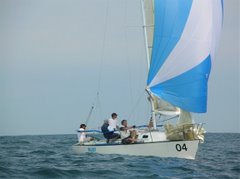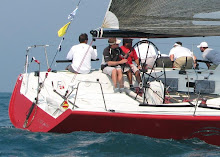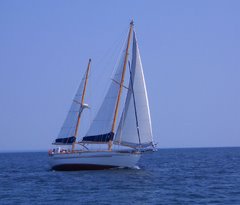
2006 World Team Race World Championships (
I have always enjoyed racing box rule boats, IOR One-tons, IOR 50s, ILC 40s, MORC Maxis, it just doesn’t matter, I personally enjoy seeing the advancement of the box rule, so that fact that the TP52s that race in the Med appear to be distant cousins to the first generation of boats matters little to me. In the end the Sardinia Cup was a great opportunity for our team to trial one of the B&C designs built specifically for the Med, and for our owner to see if this is where he wanted to spend his sailing budget.
Trans Pac 52s in the
As I indicated last week, based on our promising performance in the Global Championships, we were invited to compete at the Rolex World Team Race Championships in
In 2006 the fleet grew to roughly 22 including new designs from B&C, Farr, Brenta, and the series winner (Mutua Madrilena MM) from Rolf Vrolijk. From 2005 to 2006 the fleet evolved dramatically from going fast in a straight line (I am oversimplifying here) to much more focus on holding a line upwind (since the fleet doubled in size) and keel and hull shape changes bore this out. However a strong showing from the 2005 Siemens (Patches – 2006 Globals winner) and continued bursts of speed from the 2005 B&C and Farr designs, it showed that you did not need the newest boat to win races.
It will be interesting to see what happens in 2007 as the level is upped even further than MM pushed it in 2006 and if the fleet can continue its rapid growth with a rumored 25 boats ready for 2007 and nine new teams hitting the water. However, 2007 will be critical year as the fleet appears to be hitting a plateau with key team such as Orlanda (2005), Atalanti (2006) and Rush (2006) appearing not to be returning this summer.
Observation 1: Spars - The standard for many years were two-spreadered Hall spars. Last year we used two different generations of the Hall spars and became quite familiar with tuning it but after attending the Sardinia Cup and looking closely at what was coming out of
Observation 2: Sail inventory – The good the bad and the ugly – we saw all three over the course of the Globals and the Sardinia Cup. In my mind biggest source of evolution through 2006 and into 2007 is the transition between the Masthead Genoa and the Asymmetric A0 – we used our A0 spinnaker very effectively last year on Glory on the Swiftsure Offshore Classic but struggled with the Genoa/A0 combination during the Sardinia Cup distance race. We have been looking very closely at this set up over the last few months and we will need to do some serious testing in April and May if we are going to get it right come race day. One thing that really stood out looking at the sail programs while in
Side Note: Sponsorship – everyone on our team was surprised at the level of sponsorship in the Med. What I think stands out the most for me, was the number of Farr 40s changing sponsorship between the Farr 40 European Championships and the Sardinia Cup. Teams were literally tearing 10-20 foot logos off the hulls and replacing them with the next batch of sponsors before the next event. We felt really lucky to be involved with a great group of companies with both WOKITA.Com and Gaastra showing us what could be done sponsor-wise in
Later this week – Overview of this summer’s sailing and the new boat.





